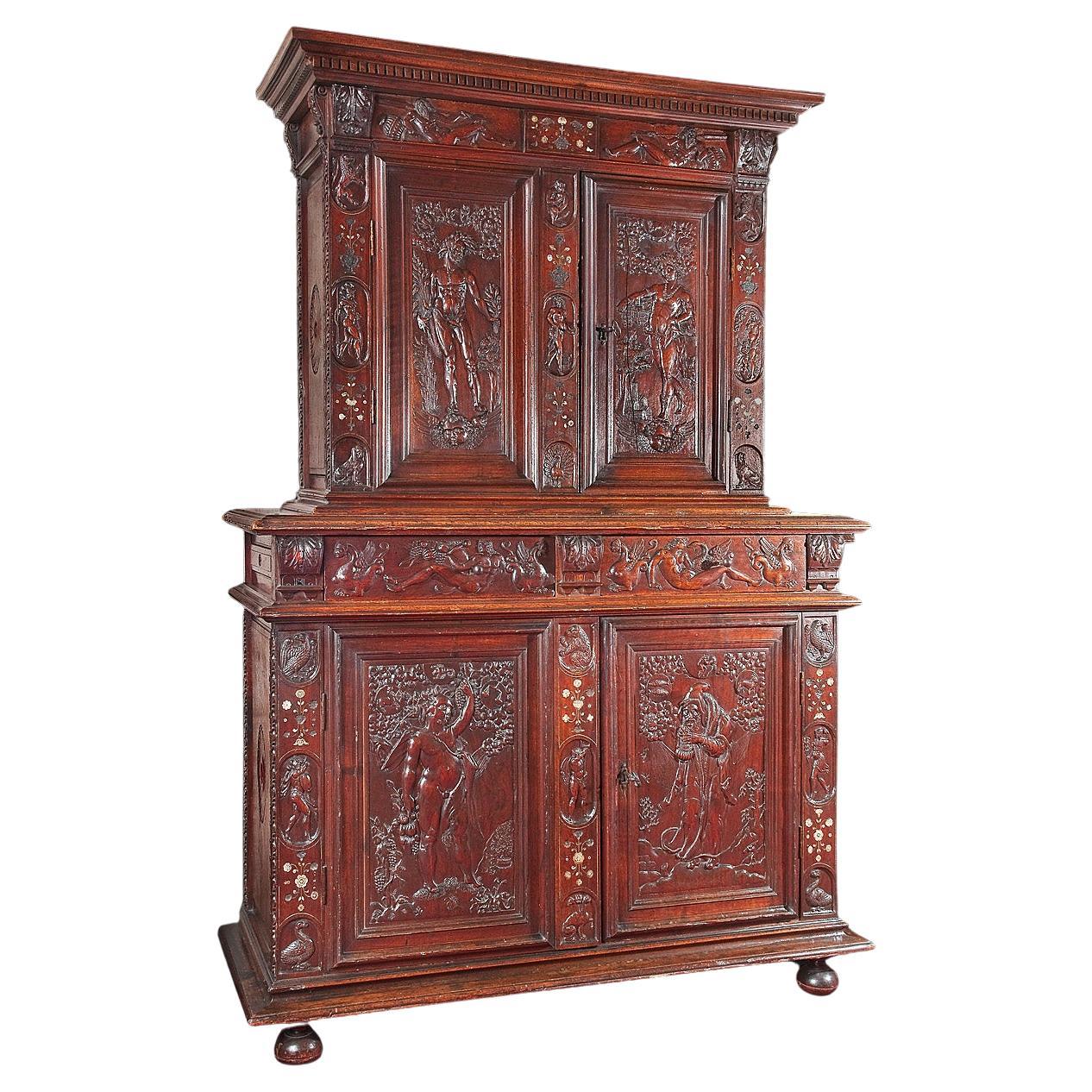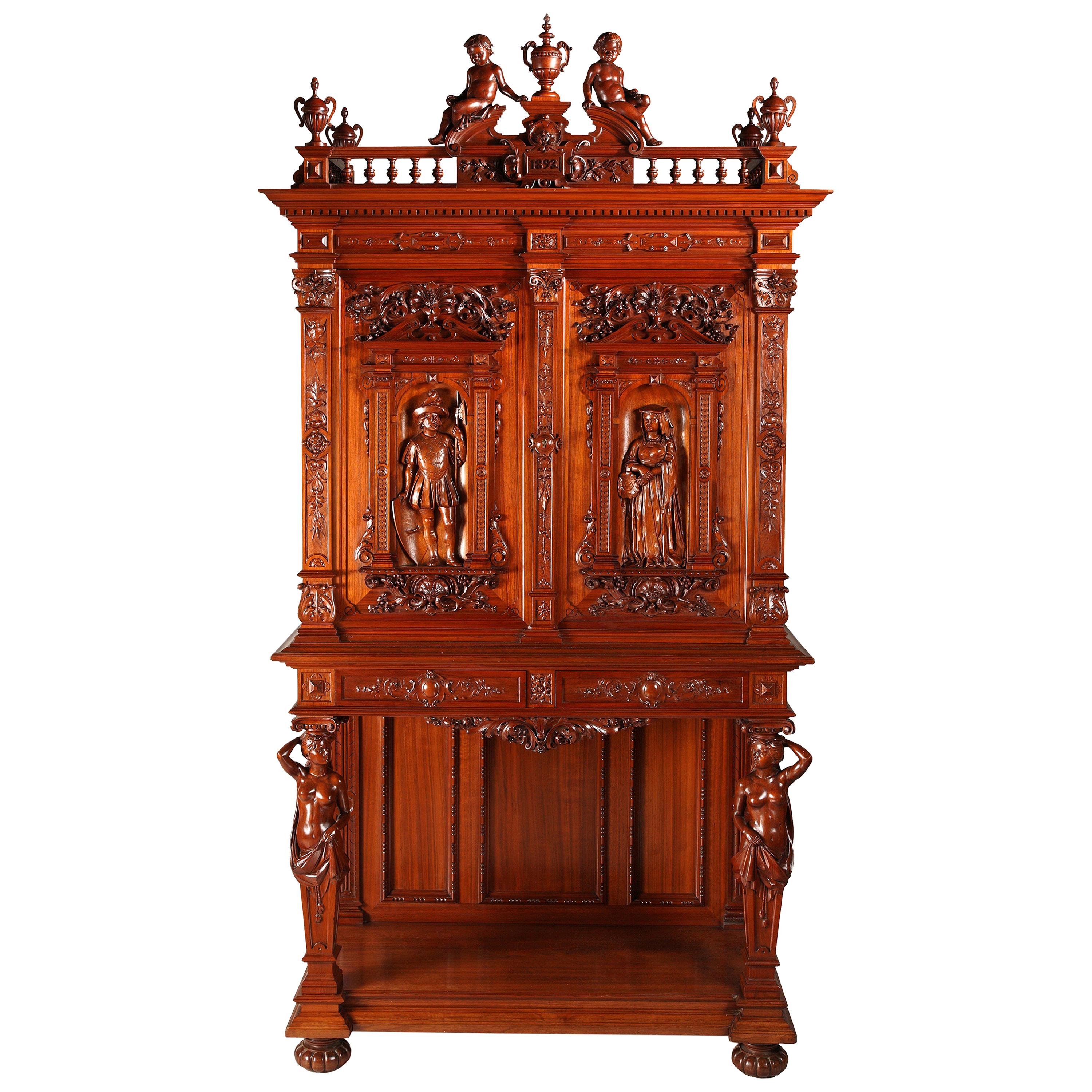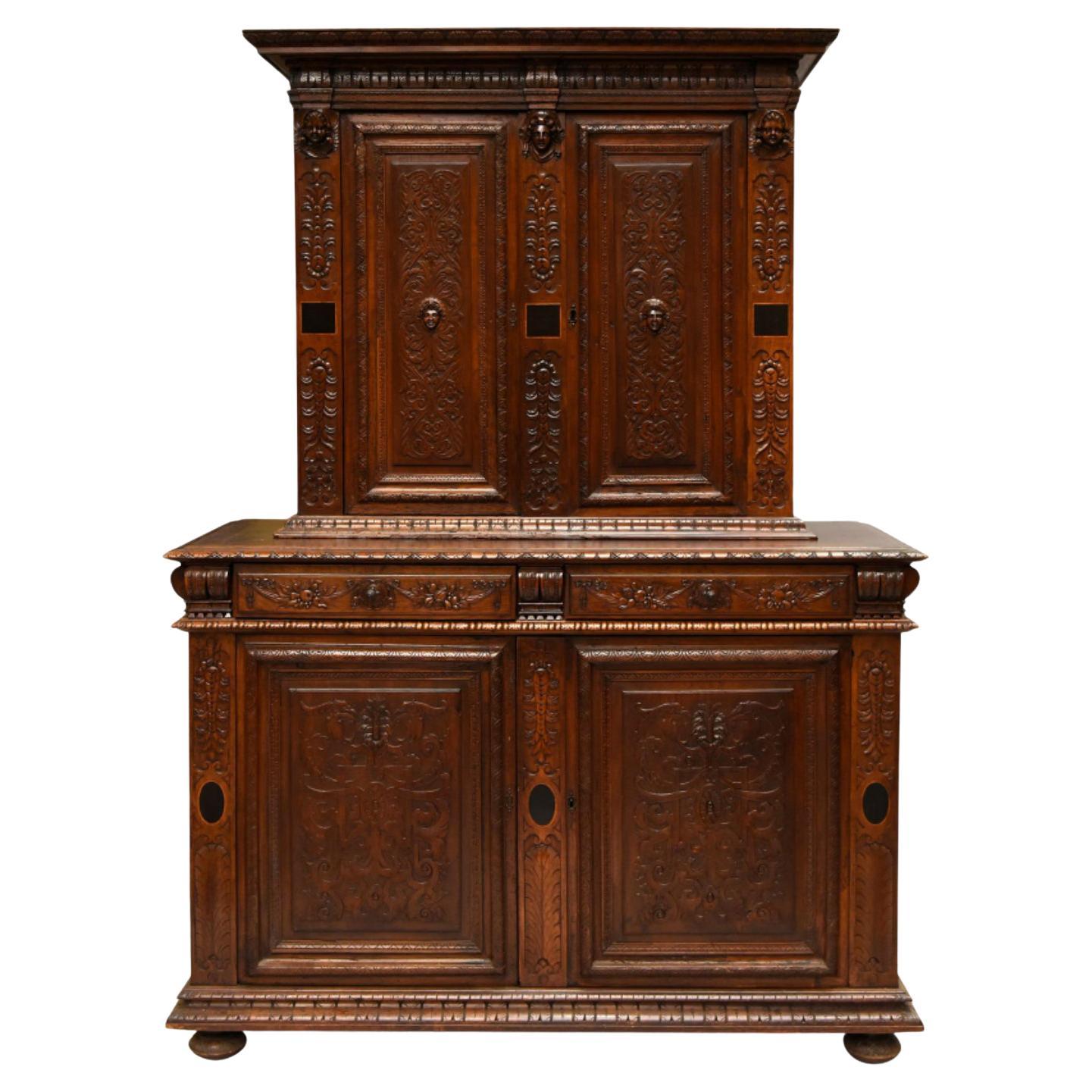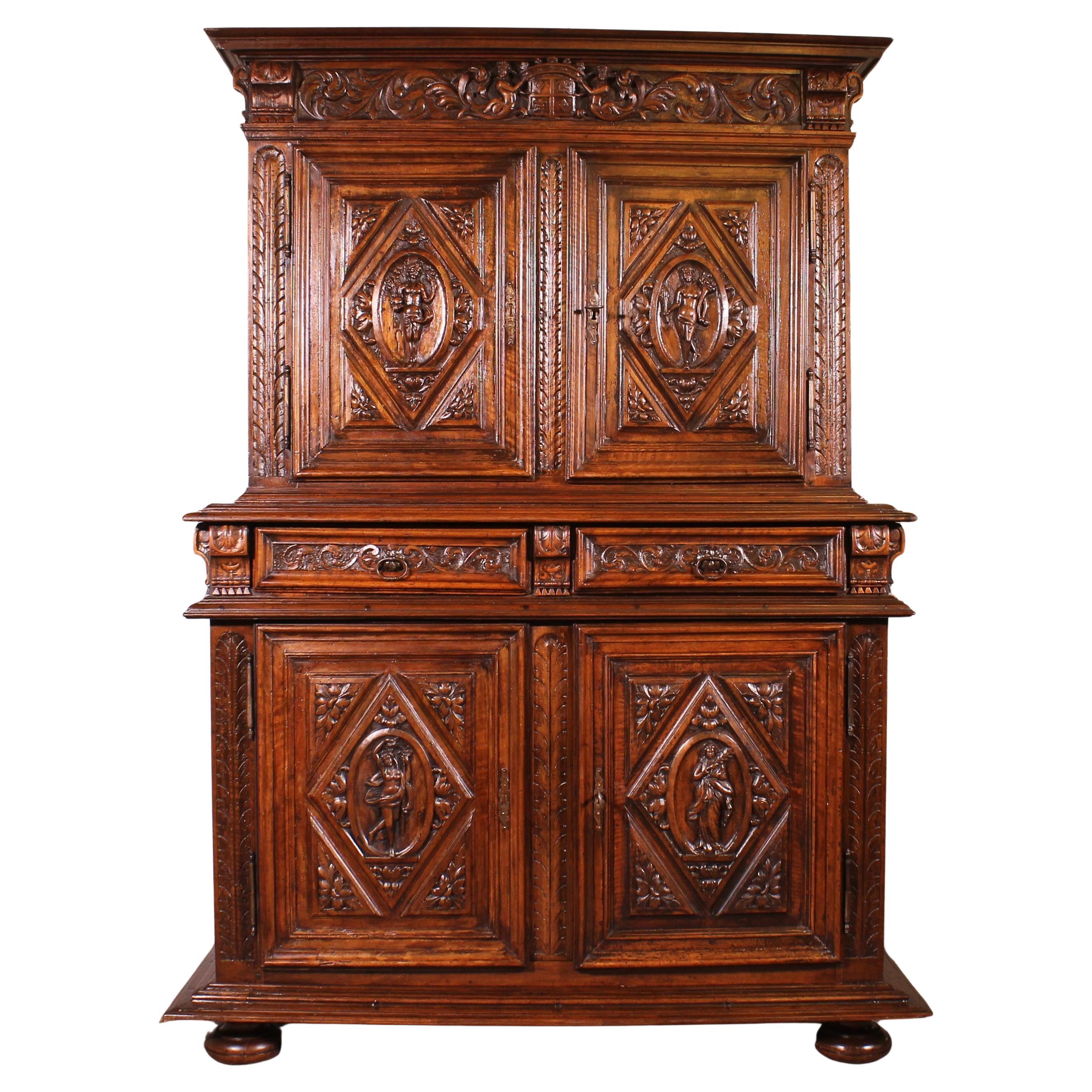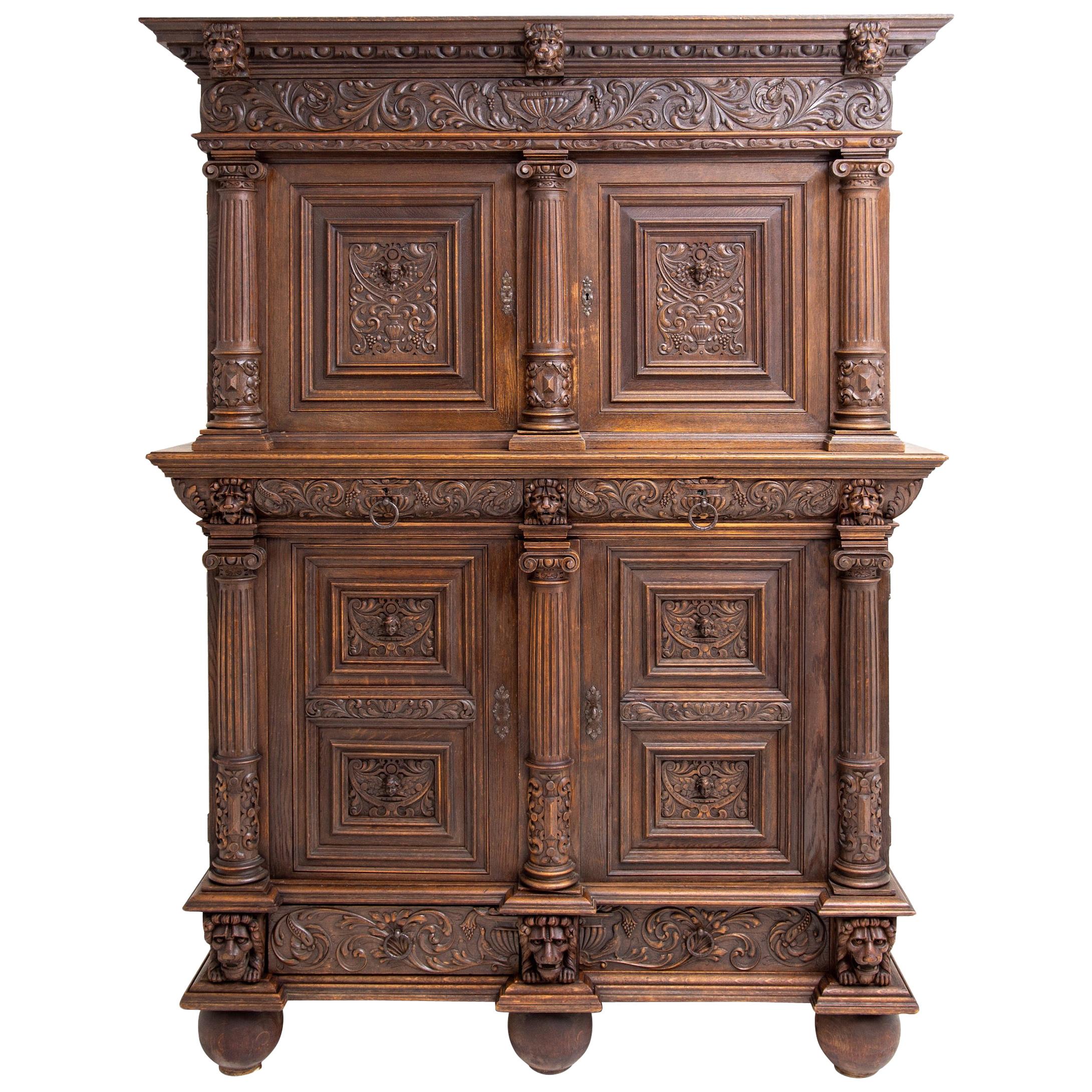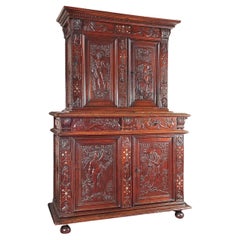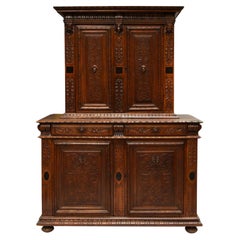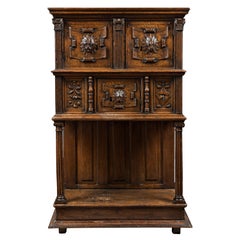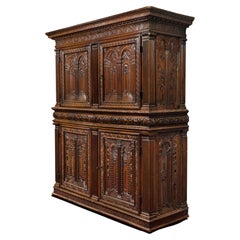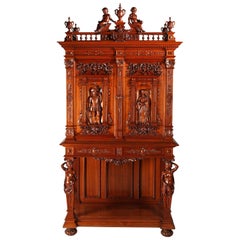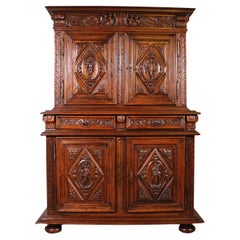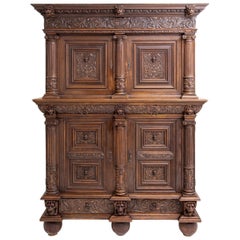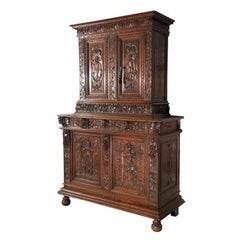Items Similar to Rare Renaissance Dresser with Marquetry and Pastiglia, from Alsace 'France'
Want more images or videos?
Request additional images or videos from the seller
1 of 6
Rare Renaissance Dresser with Marquetry and Pastiglia, from Alsace 'France'
$84,255.24
£61,294.76
€70,000
CA$114,984.23
A$128,045.31
CHF 66,640.51
MX$1,578,783.18
NOK 848,717.82
SEK 797,712.47
DKK 532,732.59
Shipping
Retrieving quote...The 1stDibs Promise:
Authenticity Guarantee,
Money-Back Guarantee,
24-Hour Cancellation
About the Item
This sideboard, with rich marquetry decoration, consists of two parts. The decorated upper body allows for the display of fine silverware. Superb carved rams' heads emerge from each corner, standing on trays of fruit. Fruits and weapon trophies on both lateral uprights and the casing give the body a ternary rhythm, whereas the two doors depict a fine winding floral pattern, work typical of German artists, who were masters in the field.
The use of different techniques and types of wood combine to create a rare decorative unity of the highest quality, playing with two effects; one being shadow and light and the other being the tones of light and dark wood.
The first effect refers to the carving, sculpture in the round or very high relief, made out of reported elements, and is limited to the upper part of the dresser; consoles of acanthus leaves on the central belt and the balusters. Then on the entablature, there is a winged angel’s face with round cheeks and curly hair, and very elegant rams' heads.
Such carvings are typical of the French Renaissance style, based on Italian patterns.
The second effect is based on a technique born in Italy, inlaying, becoming marquetry when set into the wood without drilling into the support, like for a veneer leaf. Widely spread, this technique has been reused and developed, especially in Germanic countries, where artists and cabinetmakers became masters in the field.
Their influence is obvious here, whether they carried out or inspired these designs. The decorative compositions from the Welschart ‘Renaissance’ combine the use of a wide variety of wood with contrasting tones, as well as the use of the pastiglia technique, whereby a white paste is applied in furrows hollowed out of the wood. Clear arabesques are organised around a dark mirror on the lateral faces, cornucopias and foliage on the belt, drawers and entablature.
The upper body
The architrave stands on two columns with ionic capitals, turned in baluster and wrapped with a light foliate design in marquetry. It has a frieze inlayed with foliage and at its centre, is a carved winged putti’s head, with curly hair. This architrave bears some finely carved rams' heads with elongated muzzles, on the front and rear corners.
On the back panel, there is a view with a gated entrance to a city, a castle, a bridge, a house and a boat. This is flanked by two small panels decorated with floral patterns.
On each of these smaller panels is depicted a ewer standing on a mount in a rocky landscape. From the vase emerges an axis from which flowers, roses and columbines grow, ending up in a symmetrical bouquet. On each of the panels, a small church and a house are placed in a way that frames the central scene.
The central panel is reminiscent of the work done by German inlayers, using perspective.
In the foreground, on the left, there is a tall building which consists of a two story house with windows, on top of a gallery with open archways. A chimney, from which smoke escapes, is also depicted in order to emphasise realism.
In the middle-distance is depicted a gate way of a city with a lowered drawbridge, leading onto a bridge and making a path which provides an exit for the horse that walks upon it.
On the right there is a castle built on a rock. It has two entrance towers with crenulations and its lifted portcullis is ready to welcome a halbardier.
In the middle of the background a vessel is depicted, with a mast with folded sails.
The lower body
Standing on flattened round feet, the curved moulded base holds the uprights, decorated with successive falls, fruits (apples/pears) and wheat, crowned by a Venetian mask.
On the central casing the pattern is different. It includes drums, weapon trophies in which we see an antique sword depicted three times, described as a ‘badelaire’ in the 16th century texts.
This piece of furniture opens with two finely and elegantly decorated doors. Flanked by two trees emerging from rocky grounds, a beautiful round cup stands on a square mount. In the centre is placed an axis with three levels. From four levels emerge pairs of stems with beautiful twisted foliate patterns which interlace each other. Fruits, flowers, and ears of wheat appear.Above, the belt is divided by three consoles of acanthus leaves. It opens by two drawers decorated with cornucopia patterns, from which fruits and large curled floral stems emerge. This Alsatian motif which is called Maikrug ‘Rose of May’ Mixes with the omnipresence of the Rollwerk in other words arabesque.
The board, on which the upper body stands, is decorated on three sides with an inlayed frieze, similar to the one depicted on the architrave.
The sides
The sides are filled with wonderful pastiglia work, spread out in a frieze on the belt and in a large grotesque, from which the white-cream colour sparkles on the walnut background.
The artist chisels out the design to be represented in the wood, and then fills the furrow with pastiglia or crushed eggshell mixed with animal glue.
These latteral sides express the influence of Eck Veit, carpenter, cabinet-maker and engraver (d. 1604). This Strasbourg’s statt schreyner (carpenter of the city) published in 1596 his Kunstbüchlein (Book of Art) whith 25 full-page engravings whose purpose is to « deliver the fruit of a long life’s experience by gathering some designs used in the practice of the craft ». A book extremely modern considering that for the first time its author is no longer an artist expressing his theories but a craftman itself. Eck exposed his taste for scrolls networks growing around a central motif, as here the two mirrors. Furthermore the marquetry’s design on the belt’s latteral sides evokes the reuses of ironwork forms much appreciated by cabinetmakers in Alsace such as Eck Veit.
Nevertheless with our sideboard the treatment of the motifs is freer compared to the rigour revealed by Eck. It leads to imagine a later craftman, probably from the 2nd Alsatian Renaissance.
This piece of furniture illustrates the double Italiano-Germanic inspiration, as well as the quality ‘savoir-faire’ both in the carving and the marquetry work.
- Dimensions:Height: 64.77 in (164.5 cm)Width: 50.4 in (128 cm)Depth: 23.04 in (58.5 cm)
- Style:Renaissance (Of the Period)
- Materials and Techniques:
- Place of Origin:
- Period:Early 17th Century
- Date of Manufacture:End of 16th Century-Early 17th Century
- Condition:Wear consistent with age and use. Minor losses.
- Seller Location:Saint-Ouen, FR
- Reference Number:1stDibs: LU3115327198392
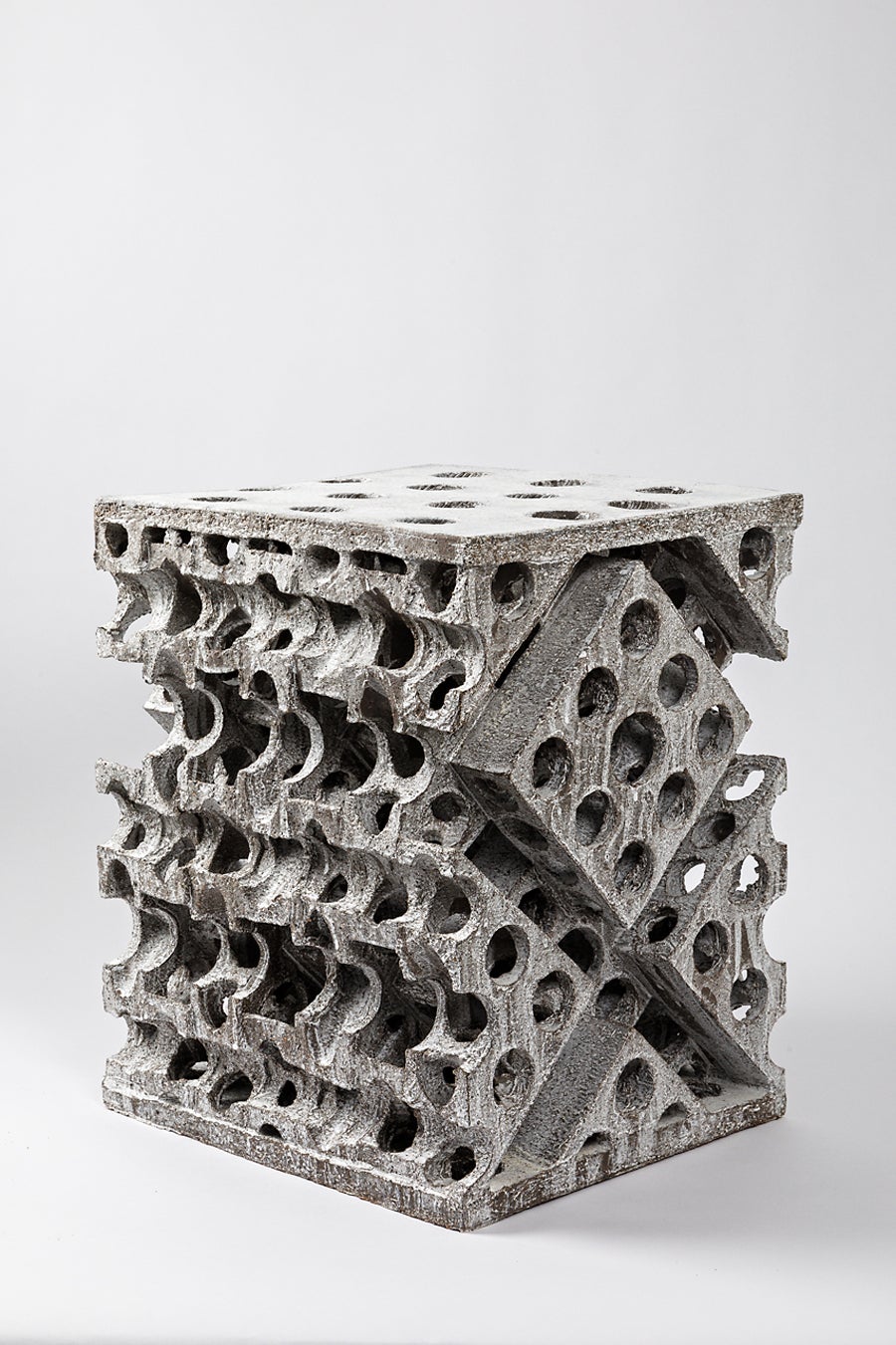
About the Seller
5.0
Vetted Professional Seller
Every seller passes strict standards for authenticity and reliability
Established in 2016
1stDibs seller since 2017
188 sales on 1stDibs
Typical response time: 3 hours
- ShippingRetrieving quote...Shipping from: Saint-Ouen, France
- Return Policy
Authenticity Guarantee
In the unlikely event there’s an issue with an item’s authenticity, contact us within 1 year for a full refund. DetailsMoney-Back Guarantee
If your item is not as described, is damaged in transit, or does not arrive, contact us within 7 days for a full refund. Details24-Hour Cancellation
You have a 24-hour grace period in which to reconsider your purchase, with no questions asked.Vetted Professional Sellers
Our world-class sellers must adhere to strict standards for service and quality, maintaining the integrity of our listings.Price-Match Guarantee
If you find that a seller listed the same item for a lower price elsewhere, we’ll match it.Trusted Global Delivery
Our best-in-class carrier network provides specialized shipping options worldwide, including custom delivery.More From This Seller
View AllRare Renaissance Cabinet Richly Carved
Located in Saint-Ouen, FR
This rare Renaissance cabinet is richly decorated on the doors and drawers with carvings depicting the four seasons, and on the uprights and the entablature, alternating flower bouquets inlaid with mother of pearl. This is a beautifully conceived piece of furniture, representing a crowned portico with its entablature and cornice.
The upper body
Articulated separately in a ternary rhythm, as with the lower body, the upper part opens with two carved doors. The doors are framed by both the lateral uprights and the casing. There are cartouches carved into the casing in which mythological figures are depicted with flower bouquets.
On the doors:
On the right: Spring, a female figure crowned with a wreath of leaves, holding a basket full of flowers. She is wearing necklaces and bracelets on each arm, with drapery discretely wrapped around her body and is standing on a winged putti’s head. On each side are depicted a tree and a village with a steepled church. Above her head floats the three signs of the zodiac corresponding to the season: Aries, Taurus and Gemini.
On the left: Summer, a bearded man crowned with ears of corn and bearing armfuls of corn. He is standing on a similar winged putti, flanked by a tree and an ear of corn. The following three signs of the zodiac appear: Cancer, Leo and Virgo.
On the uprights and the central casing a number of smaller figures seem to represent virtues and vices that newly wedded couples should aspire to and avoid.
On each side, at the bottom of the uprights, there is a dog representing fidelity. Above, a lion embodies power, wisdom, and justice.
In between, on the left upright, there is a figure of noncombatant Athena wearing a helmet and holding a spear, an arrow pointing down and in her left hand, a shield, symbol of protective power. On the right upright, the goddess Venus controls the arrow of Cupid.
The iconography here acts as a clear reminder of the required virtues that both parts of a young couple need to fulfill: fidelity, power, wisdom and justice. For him, the goddess Athena focuses on the power. Whereas for her, it is Venus who shows how to control Cupid’s arrow.
On the central casing at the bottom, by way of contrast, there is a peacock, a symbol of pride and at the top, a monkey representing lust and mischief. In between, a woman holding a chain and a cup full of precious stones while on the floor sits a half empty opened casket. This can be interpreted as a symbol of extravagance.
Above, the entablature, decorated with male figures resting on leaking urns, may symbolize the passing of time. They are flanked by two consoles decorated with acanthus leaves and separated by flower bouquets (inlaid with mother of pearl). Finally on top, a cornice acts as a crown for the piece of furniture.
The lower body
The moulded base stands on four round, flattened feet.
Represented on the doors:
On the left: Autumn, a stocky, naked man crowned with vine leaves, holding fruits in his right hand and with his left, picking a bunch of grapes from a climbing vine. Standing on a mound, he is surrounded by a vine and a hill, at the foot of which a man presses the grapes in a big vat after the harvest. Above the climbing vine appear the signs of Libra, Scorpio and Sagittarius.
On the right: Winter, an elderly man wearing a fur cloak...
Category
Antique 16th Century French Renaissance Cabinets
Materials
Walnut
Renaissance Cabinet form Lyon 'France'
Located in Saint-Ouen, FR
Condition : Partly dating from the Renaissance. The backs and the drawer’s insides have been re-done.
Historical background
The 16th century is a prosperous period for Lyon...
Category
Antique 16th Century French Renaissance Cabinets
Materials
Walnut
First French Renaissance Dresser
Located in Saint-Ouen, FR
Provenance : Chabrières Arlès collection then through descent
Under the reign of Henry II, during the French Renaissance, the rigour of composi...
Category
Antique 16th Century French Renaissance Dressers
Materials
Oak
Important Renaissance Cabinet from Lyon 'France' with a Decor of Perspectives
Located in Saint-Ouen, FR
As soon as 1540 France's second Renaissance is in the making, intimately linked to the rediscovery of the Antique world. The development of the printing and engraving industry allows the spread of artworks and models in many cities and countries. The Italian influence can be perceived in every artistic field. While the French king entrust the most talented Italian artists with major projects such as Il Rosso or Primaticcio in Fontainebleau, French artists also travel to Italy to form themselves to this new style. In Italy they get acquainted with the work of Leo Battista Alberti the first to theorize perspective (De Pictura, 1435-36) and architecture (De re oedificatoria, 1541). Those two publications would have a revolutionary impact on arts.
Furniture is marked by the work of the most famous Italian architects of the time as well as French architects. Indeed Philibert de l'Orme competes with Alberti and by the end of his life publishes several treaties including one devoted to a theory of architecture (1567). Unfortunately he would not live to complete the second volume. In this treaty he expresses his interest for mathematical norms applied to architecture, copied from the Antique. His journeys in Italy allowed him to accumulate the most sophisticated references. Jean Bullant, another architect of great talent also theorizes his practice. He establishes rules characterizing Greco-Roman art staying faithful to Vitruvius.
Following this new inspiration the structure of furniture evolves. From then on appear columns, capitals, cornices, friezes and architraves. The ornamentation uses this inspiration as well with egg-and-dart, palm leaf and rose adorning the most beautiful pieces.
In Lyon, crossroad where meet merchants from everywhere those new experiments are welcomed. Lyon florishing printing industry allows the spreading of models and treaties essential to the artist's work. Thus the first publication of Vitruvius' De Architectura in France would be printed in Lyon in 1532.
Artists from Lyon rediscover and familiarize themselves with the Antique knowledge very early. They adopt those new ideas and use them in their own creations. Lyon cabinet-makers re interpret Antique architecture and Italian Renaissance palaces to give their pieces a pure and harmonious architectural structure. Grooved pilasters are particularly favored. They are topped by capitals of diverse orders always respecting the sequencing with simpler ones for the lower levels and the richest ones on the higher levels. As for the ornamentation, one of the great distinctiveness of Lyon workshops remains the architectural perspective illusions, drawing inspiration from Tuscany.
True masterpiece of the Second French Renaissance this important cabinet illustrates Lyon workshops' taste for fine Italian architecture inspired by Antiquity. An architectural perspective of great quality is treated in symmetry on each panel.
This two-bodied cabinet without recess stands on four rectangular feet. The base comprises a molding, a palm leaf frieze and is bordered by a braid.
The lower body is divided by three grooved pilasters with Tuscan capitals framing two door-leaves. The two panels are encircled by a moudled frame with palm leaves. They are finely carved with a decor of fantasized architecture depicting an Italian Renaissance palace erected symmetrically on each side of a grooved pilaster. On the ground floor a door opens through a stilted arch while the stories are opened with mullioned windows, dormers and occuli. Two large pegged-boss cladded pillars support the entablature enriched by a palm leaf frieze upon which stands an arch whose coffered intrados is centred by a rose. Behind this arch a pyramid appears, standing in front of a second facade with a window topped by a broken curvilinear pediment under a cul-de-four with a shell.
The checker flooring gives depth to the low-reliefs creating vanishing points structuring the panels and guiding the eye of the observer.
A thin laurel braid highlights the belt of the cabinet where are located two drawers. Their facades are adorned by palm leaves in hoops.
The upper body is encircled with palm leaves. The same ternary division as in the lower body appears. However, the pilasters are topped by Ionic capitals with volutes and egg-and-dart. The door-leaves are framed with flowers. On the panels the artist has designed another architectural decor. On the foreground open two arches on top of grooved pilasters with rectangular capitals adorned with palm leaves. The arches are enriched with braids and the coffered intrados bears a decor of roses. The spandrels also bear a flower decor. In the background another arcature hosts a fluted grooved column topped with double basket acanthus capital, characteristic of Corinthian order. The triangular pediment is interrupted by a choux bourguignon.
A large cornice crowns the cabinet. It stands on pilasters and forms an entablature comprising a palm leaf frieze and an egg-and-dart, triglyph and palm leaf cornice.
The cabinet's sides have also been carefully considered. The lower body's panels are enriched with an arch rising above a broken pediment portico hosting a twisted column. Flowers garnish the spandrels. An architectural facade completes the decor. The upper body's panels present two arches supported by a facade opened with dormers and mullioned windows as well as cartouches (one bears the inscription 1580 dating the cabinet) suggesting the interior of an Italian Renaissance palace, confirmed by the chandeliers. The flooring leads our gaze to a second arch with a broken curvilinear pediment where stands a flower vase. This arch opens onto a perspective of another facade along a road.
Inside the cabinet, on the lower body door-leaves appear two designs. On the right door is depicted a Crucifixion. Saint Mary and Saint John flank the Christ on the cross. In the bottom part is inscribed « Dure uiator abis nihil haec spectacula curas / Pendenti cum sis unica cura Deo. / Tota suo moriente dolet natura Magistro. / Nil qui solus eras caussa dolenda doles. ». The signature [Christoff Swartz Monachiensis pinx[it] / Ioa[nnes] Sadeler sculp[it]] tells us it was made by Johan Sadeler I (1550-1600) after Christoph Schwartz (1548-1592). This engraving belongs to an ensemble depicting the Passion of Christ Johan Sadeler executed in 1589 after an altar piece painted by Christoph Schwartz for the private chapel of Renée of Loraine, wife of Duke William V of Bavaria. This altar piece made of nine copper panels has been destroyed during the 19th century. The Crucifixion panel once in the centre of the altar piece is the only one that survived and is today kept in Munich's Alte Pinakothek.
On the left door appears Saint Francis receiving the stigmata. The inscription says : « Signastidomine Servum Tuum. Franciscum. Signis Redemptionis Nostrae ».
This Renaissance cabinet with an architectural decor appearing as much in the structure faithful to Antique rules...
Category
Antique 16th Century European Renaissance Cabinets
Materials
Walnut
16th Century French Walnut Cabinet with Marble Inlays
Located in Saint-Ouen, FR
On the left post of the lower body, is written the date 1596 in a cartouche
This cabinet has two bodies. The upper part, set back, is moulded and carved. At the bottom, the cabine...
Category
Antique 16th Century French Renaissance Cabinets
Materials
Walnut
French Renaissance Cabinet with Perspectives
Located in Saint-Ouen, FR
This Renaissance Cabinet reveals the great mastery of the Lyon workshops which are at the origin of its realization. Sculptors and wood-carvers worked here in symbiosis to express an...
Category
Antique 16th Century French Renaissance Cabinets
Materials
Walnut
You May Also Like
Renaissance Style Wooden Cabinet Attributed to H.A. Fourdinois, France, 1893
Located in PARIS, FR
A wooden cupboard, elaborately carved throughout, dated "1893" on the crest and attributed to H.A. Fourdinois. The upper section with a pair of cherubs at the center of a balustrade ornamented with two-handled urns, two architectonic doors below, carved with lady and gentleman in niches surrounded by extensive carving with classical motifs. The lower section with two drawers above a standing female caryatid support at each front corner. The all reposing on four gadronned round feet.
The Fourdinois company was founded in 1835 by Alexandre-Georges Fourdinois (1799-1871). The Universal Exhibition held in London in 1851 was undoubtedly their first great artistic and public success. Winning the Great medal for a neo-Renaissance buffet...
Category
Antique 1890s French Renaissance Cabinets
Materials
Wood
$15,888 Sale Price
40% Off
Renaissance Buffet Representing The 4 Seasons Circa 1580 - France
Located in Brussels, Brussels
Superb and rare Renaissance period walnut buffet from the end of the 16th century representing the four seasons opening with four doors and two drawers on the front,
The doors offer...
Category
Antique 16th Century French Renaissance Buffets
Materials
Walnut
Neo-Renaissance Cabinet, Late 19th Century
Located in Greding, DE
A four-door cabinet in Renaissance style standing on ball feet with lion's head mascarons and half-columns with volute capitals. The doors with panels and vine decoration are separat...
Category
Antique 19th Century German Renaissance Revival Cabinets
Materials
Wood
French late 16th century Renaissance Walnut Deux-Corps cabinet
Located in Troy, NY
Beautiful French Renaissance cabinet in two parts. The top part with two carved doors featuring classical figures opening to an interior fit...
Category
Antique 16th Century French Renaissance Cabinets
Materials
Walnut
19th Century Dutch Hand Carved Renaissance Raised Cabinet
Located in Miami, FL
20th century Spanish hand carved Renaissance raised cabinet was rendered from dense, old-growth quarter sawn walnut, examples of which are on display in museums across Belgium and Ho...
Category
Antique Late 19th Century Spanish Baroque Cabinets
Materials
Walnut
French Richly Carved Sideboard Buffet - Renaissance- circa 1580 France
Located in Beuzevillette, FR
Beautiful Renaissance two-body buffet with four doors and six drawers.
On the upper part of the buffet, who hide two secrets drawers, an alternating band of three masks, represents a mythological scene: Zeus changed into a swan seduces Leda on the banks of the Eurotas. The sides of the buffet are decorated with foliage and vines. The doors cornices...
Category
Antique 16th Century French Renaissance Buffets
Materials
Walnut
More Ways To Browse
French Sword
French Carpenters
Alsace French
Italian Renaissance Light
Renaissance Art Pairings
Antique French Swords
Alsace Furniture
16th France Renaissance
Wood Furniture With Animal Motif
Carved Rams Heads
Sideboard With Flowers
17th Century German Engravings
Drum With Stand
Renaissance Cups
16th Century Venetian
17th Century Cups
Dark Walnut Console
17th Century Putti
